Brigadier General John Monash

John Monash is considered one of the war’s outstanding commanders. Monash was an avid collector, and his papers held at the Memorial give a comprehensive view of his wartime military career: from his command of the 4th Australian Brigade on Gallipoli to the Australian Corps in 1918, and then his role as Director General of Demobilisation and Repatriation of the Australian Imperial Force at war’s end. His handwritten notes, diaries, letters, draft orders, maps, and cards spanning the whole war give insight into his meticulous planning and success as a commander.
Australian 4th Brigade order no. 1
On 8 April 1915 Monash wrote to his wife:
"We got the first order issued today by General Sir I.S.M. Hamilton … This is indeed a historic document, but its contents are too confidential to send along a copy. What a wonderful compliment to Australia and New Zealand to be included in this great expedition, which I feel pretty sure will exercise a decisive influence upon the whole war."
Observation report
It is widely believed that the Gallipoli campaign was conducted with little or no aerial intelligence. But some 200 aerial missions were conducted before the landing, and the information gathered was distributed to Australian units. Among Monash’s papers are daily updates based on aerial intelligence. Aerial intelligence, however, was a new skill and in its early stages was not well-interpreted.
The night before the landing
Quiet thoughts on the eve of battle were sometimes recorded in letters and diaries. Monash wrote to his wife:
"In the event of my going out, you are to believe that I do so with only one regret, which is, the grief that this will bring to you and Burt and Mat. – For myself, I am prepared to take my chance … to win through safely would mean honour and achievement, on the other hand to fall would mean an honourable end. – At best I have only a few years of vigour left, and then would come decay and the chill of old age, and perhaps lingering illness."

